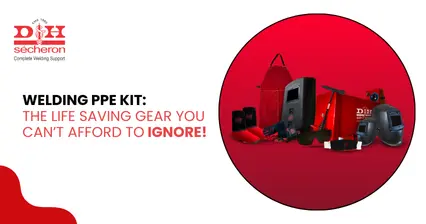The Storing and Baking Procedure of Low Hydrogen Electrodes
Low hydrogen electrodes are stick welding or Shielded Metal Arc Welding (SMAW) consumables with a low amount of hydrogen in their covering. Generally they contain less than 0.6% coating moisture whereas conventional cellulosic electrode coatings have 4-6% moisture. Low hydrogen electrodes are qualified only when they don’t have more than 0.6% moisture content at 1800°F (980°C) as per the American Welding Society (AWS) carbon steel electrode test specification.
While moisture is necessary for forming and extruding in the welding process, an excess amount of it can cause brittle failures, delayed cracking or hydrogen-induced cracking. Low hydrogen SMAW electrodes also have good penetration and deposition rates. That’s why they are commonly used in welding thick metal sections, bridge and building construction, restrained joints, power generation, and high pressure-high temperature service steels.
The AWS E7018 is the most popular electrode in this category.
How should Low Hydrogen Electrodes be stored?
If low-hydrogen electrodes are exposed to room air for a prolonged period, the coatings may absorb hydrogen from condensation. In such a scenario, it will no longer be classified as low hydrogen. Hence, when it comes to storing stick electrodes, the best practice is to store them in an airtight box or hermetically sealed container at a temperature above the dew point.
A few other guidelines for storing stick electrodes are:
If stored in a heated room in a cold place, the temperature should be above 15°C.
If stored in a hot and humid environment with relative humidity below 50%, the temperature should be ambient.
It is highly advisable to avoid storing the electrodes at a temperature more than 25°C.
Follow the First In First Out (FIFO) method to take out the electrodes for the operational purposes.
What is Low Hydrogen Baking Procedure?
However, the general practice is to dry them before every use. You can consider re-drying, breaking or reconditioning them to restore the right moisture content. Rebaking is possible, albeit under strict supervision and with precise accuracy. The electrodes can be baked for 1-2 hours at 500°F-800°F. However, it is advisable to follow AWS or manufacturer guidelines for baking the electrodes.
If you are looking for high quality low hydrogen medium and high tensile steel electrodes, you can get them from D&H Sécheron. Some of our low hydrogen electrode products include Cromotherme-1, Supratherme and Ultratherme.
Visit www.dnhsecheron.com to know more.
11 May 2025 | Welding
An In-Depth Exploration of Low-Alloy Steel: Your Comprehensive Guide
11 May 2025 | Welding
Nagpur - Bori - Tuljapur Road MSH-3 in Yavatmal District (Maharashtra)
11 May 2025 | Welding
Guidelines to Understand Gas Welding: Applications, Advantages & Disadvantages
11 May 2025 | Welding
3 Tips for Finding the Best Mild Steel Electrode for Your Application
11 May 2025 | Welding
How to Select the Right Welding Filler Wires for Stainless Steel Welding?
11 May 2025 | Welding
Building the Narendra Modi Stadium with Norma V and Autotherme-1 Electrodes
11 May 2025 | Welding
Low Alloy Steel Welding in a (PEB) Pre Engineered Building Structure
11 May 2025 | Welding
Welding Rods: Different Types and Tips for Properly Storing and Handling
11 May 2025 | Welding
Tips for Flawless Welds with Stainless Steel Electrodes: Pros and Cons
11 May 2025 | Welding
Exploring Applications and Benefits of Stainless Steel Welding Electrodes
11 May 2025 | Welding
Welding Basics: Joining Metals with Heat and Pressure - A Beginners Guide
11 May 2025 | Welding
Distinguishing Low-Alloy Steel from High-Alloy Steel: Understanding the Variations
11 May 2025 | Welding
Hard Facing Wire - Understanding the Process and Achieving Optimal Result
11 May 2025 | Welding
Exploring the Advantages of Stainless Steel Electrodes in Welding Applications
11 May 2025 | Welding
Weathering Steel vs. Traditional Steel: A Comparative Analysis of Performance
11 May 2025 | Welding
Choosing the Right Welding Rod: Why 6013 Electrodes Might Be Your Ideal Option
11 May 2025 | Welding
Why 7018 Electrodes Are Preferred for High-Strength Welds in Pipeline Construction
11 May 2025 | Welding
Filler Wire vs. Stainless Steel Filler Wire: Understanding the Key Differences
11 May 2025 | Welding
Exploring the Impact of Filler Material on Welding Quality and Durability
11 May 2025 | Welding
Choosing the Right Cast Iron Electrode for Different Welding Projects
11 May 2025 | Welding
Top Advantages of Cast Iron Electrodes for Industrial Welding Applications
11 May 2025 | Welding
Key Benefits and Challenges of Using TIG Welding in Industrial Projects
11 May 2025 | Welding
5 Reasons Why 7018 Electrode is the Gold Standard for Welding Professionals
11 May 2025 | Welding
Top 5 Advantages of Flux Cored Arc Welding for Heavy-Duty Applications.png)
11 May 2025 | Welding
Lotherme-601: A Game-Changer for Restoring Shoulder Pins in Heavy Machinery
11 May 2025 | Welding
How D&H Sécheron Helped Repair a Rotary Kiln’s Cooler Section with LoTherme 352
11 May 2025 | Welding
Piston Repair for Mining Industry: Cost-Effective Solutions with LoTherme 468.webp)

.jpg)





.jpg)








































.jpg)

.jpg)

.jpg)





.jpg)
.jpg)
.jpg)



.webp)
.jpg)
.jpg)
.webp)
.jpg)






















.png)



.webp)

.webp)
.webp)



